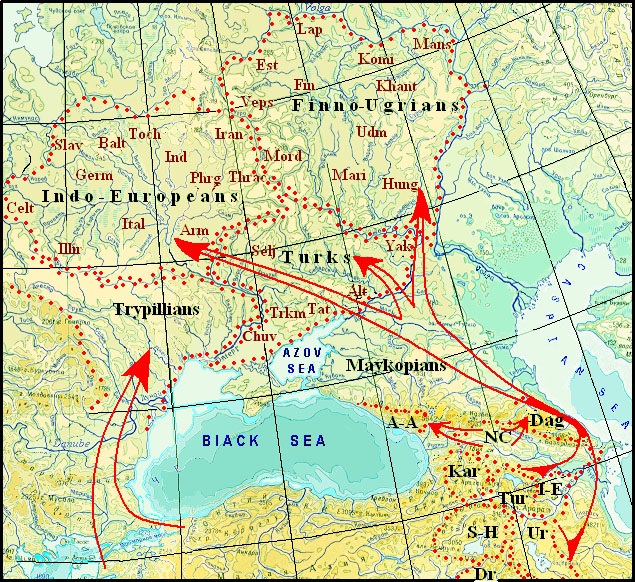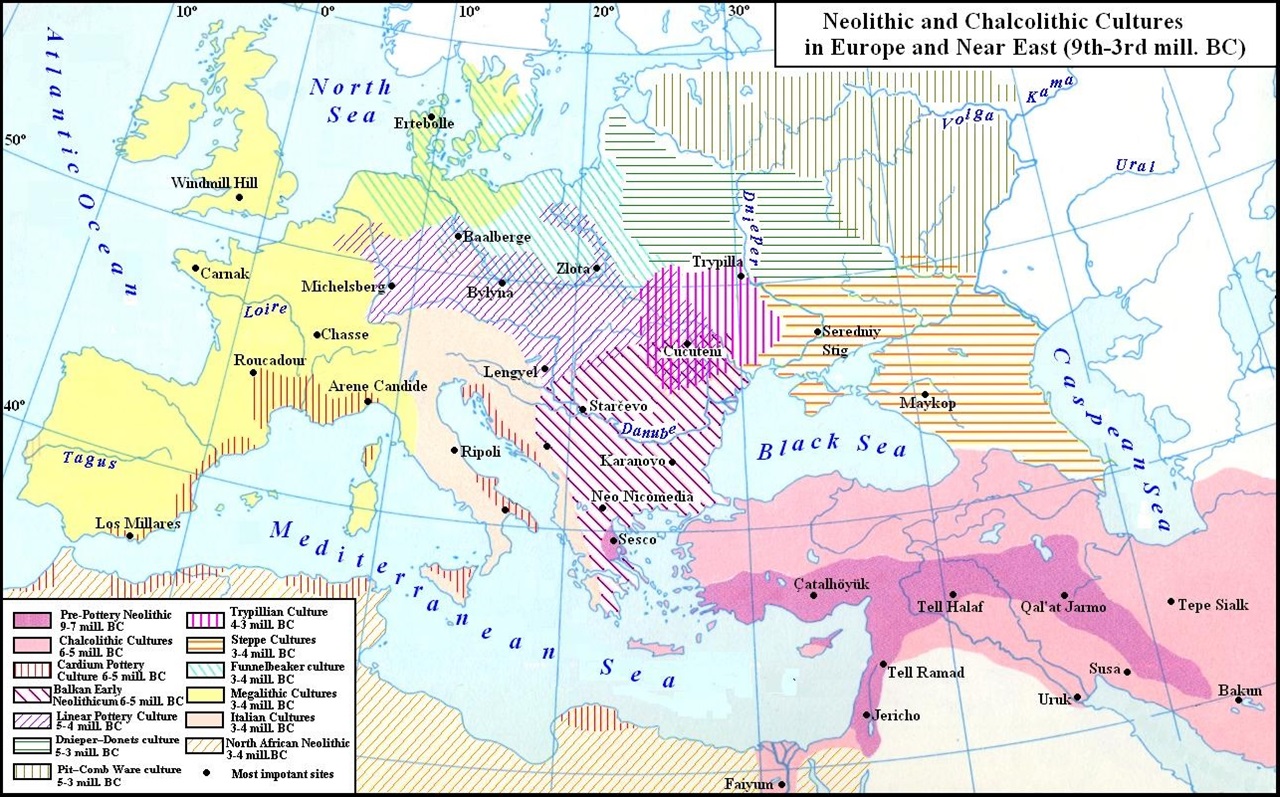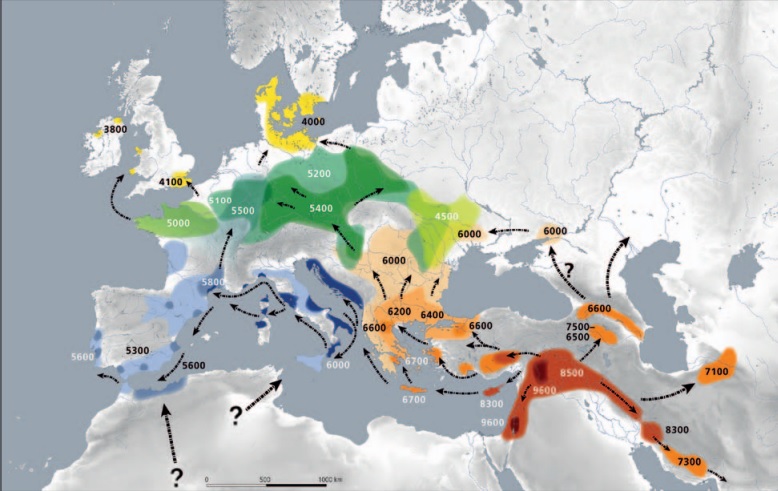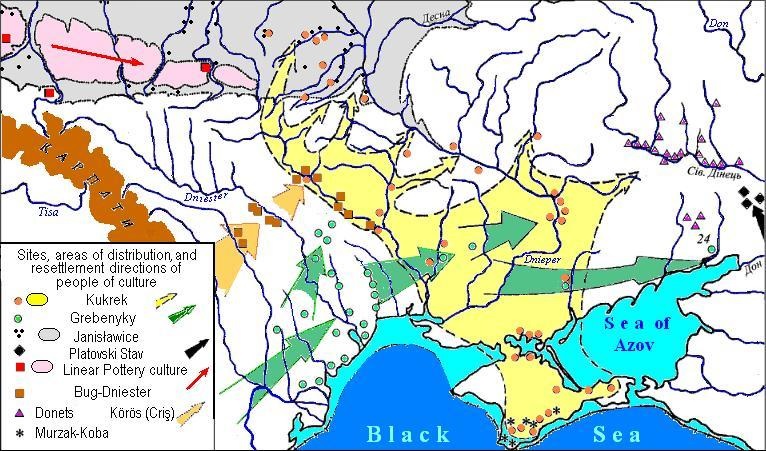First Neolithic tribes in Eastern Europe
Although the political doctrine of "liberty, equality, fraternity" contradicts the idea of natural selection, which dominates human evolution, it is accepted as an absolute and, despite its apparent humanistic coloring, hinders the development of the humanities. At present, humanists, following this doctrine, avoid talking about the different contributions of individual peoples to the development of human civilization. However, they paradoxically consider this development determined by Europe as self-evident. Modern historiography is built on this hypocrisy, which thereby sows the causes of the ongoing wars in the world, which serve as a means of resolving international conflicts. To a significant extent, the lag of the humanities most affects archeology and paleogenetics, which are called upon to study the development of human progress, and their findings are accepted as the most authoritative. Archaeology, based essentially on material facts, is guided by erroneous theories, placing itself in a subordinate position to linguistics, which is organically devoid of impartiality and often serves political goals. Following archaeology, these same theories are used by paleogeneticists. An example is the dominant European sciences' attribution of the creators of the Yamnaya culture to the Indo-Europeans, and not to the Turks. Such examples lead to the fact that the development of the scientific understanding of human progress is chaotic, starting with the Neolithic revolution, which began in the Middle East through the efforts of a limited number of ethnic groups. It is precisely the ideas about these groups in science that are vague and apply to all of humanity as a whole. Accordingly, their contribution of different peoples to the development of human civilization is not specifically noted for reasons of political correctness, and this is considered fair (see the map in Fig. 1).
Fig. 2 The position of the forest-steppe boundary in the Neolithic and the present
(according to palynological analysis). The main sections of the Holocene deposits for a time slice of 5800 – 5500 years ago (SPIRIDONOVA E.A., ALESHINSKAYA A.S. 1999, 28).
Symbols: а – the position of the forest-steppe border 5800 – 5500 years ago, б – the current position of the forest-steppe border.
Triangles indicate peatlands, dots indicate settlements, etc.
In the steppe of the Black Sea coast between the Ingulets River and the mouth of the Danube, sites of Hrebennyky culture were prevalent, the economy of which was based on hunting for a tour and a horse. The genetic roots of this Late Mesolithic culture are hidden in the Balkans [ZALIZNIAK L.L. 1995-3: 6-8]. The cultural flow penetrating from Anatolia to southeastern Europe through the Aegean space brought important changes to the economy of the Eastern European population. The transition to a new form of economy in the steppe conditions is demonstrated by the creators of the local Kukrek culture (middle 8th – late 7th millennium BC). Without abandoning traditional management, they began to use domestic cattle and small livestock. The meadow vegetation in the steppe provides good fodder for livestock, so the small population there did not need to turn to agriculture.
Since the 6th millennium BC, the territory of Eastern Europe began to be populated by agricultural communities of Anatolia and the Caucasus moving through the Balkans and the North Caucasus. They brought the Neolithic cultures to Ukraine, the first of which occurred in the southern and south-western regions of the country – on the Dniester, the Southern Bug Rivers, in the lower reaches of the Dnieper, in the Crimea, and the Carpathians. In particular, the aliens created the Bug-Dniester culture based on the final phase of the Kukrek culture. It certainly had connections with more advanced synchronous cultures of South-Eastern Europe. Somewhat later, tribes speaking languages of the Nostratic macrofamily moved from the Caucasian, and this certainty allows us to talk about the ethnicity of many different cultures.
Fig. 3. Migration of Proto-Neolithic and Early-Neolithic population during the second half of VII – the beginning of VI millennia BC., maybe partly stimulated Early-Atlantic transgression of the Black Sea.
Original of the map (ZALIZNIAK L.L. 2005: 10. Fig. 4) was colored by the author. The dark blue color shows the waters of the Black Sea in the early Holocene, blue indicates flooding of the land.
The first Neolithic culture on the Left Bank of Ukraine in the 5th millennium BC was the Sursk-Dnieper culture, which was formed based on the Mesolithic and more Eastern culture (came perhaps from the region of the Azov Sea). Having existed for 1–1.5 thousand years, it seemed to dissolve in later cultures. [ARTEMENKO I.I. (Ed.) 1985: 139]. The ethnicity of the creators of this culture is difficult to determine. Probably, these were some North Caucasian tribes oppressed by Indo-Europeans, who were the first among the Nostratic tribes to move to Eastern Europe along the western coast of the Caspian Sea from their ancestral homeland in Transcaucasia. Following them, the Turkic and Altai peoples moved along the same path (see map in Fig. 4)

Fig.4. The Resettlement of the Indo-European, Turkic, and Finno-Ugric tribes in Eastern Europe.
Legend: Nostratic peoples: A-A – Abkhazo-Adyge, Dag – Dagestanians, Dr – Dravidians, Kar – Kartvelians, I-E – Indo-Europeans, NC – the speakers of North Caucasian language, S/H – Semites-Hamits, Trk – Türks, Ur – Uralians.
Indo-European peoples: Arm – Armenians, Balt – Balts, Gr – Greeks, Germ – Germanic, Illyrians, Ind – Indo-Aryans, Ir – Iranians, Ital – Italics, Celt – Celtic, Slav – Slavs, Toch – Tocharians, Thrac – Thracians, Phrig Phrygians.
Finno-Ugric peoples: Est – Estonians, Fin -Finns, Hung -Hungarians, Khant – Khanty, Lap – Sami, Mans – Mansi, Mord – Mordvinians, Udm – Udmurts.
Turkic peoples: Alt – South Altaians, Chuv – Proto-Chuvashes, Yak – Yakuts, Khak – Khakasians, Tat – Tatars, Trkm -Turkmens.
Retreating under the pressure of the Turkic people in the area of the middle Dnieper, the Indo-Europeans could not pass the Seversky Donets basin. So we can associate with them the Dnieper-Donets culture, which was the main significance and territory of the Neolithic culture in Ukraine. It stretched approximately 2 thousand years, from the 7th to the 5th thousand BC. Daily dating by the radiocarbon method indicates the following dates of foundation of the crop: 6500 – 4200 rubles. BC. It appeared on the Left Bank of Ukraine in the Donets River valleys after the Sursk-Dnieper culture in the 5th millennium. BC. In time, the tribes of the Dnieper-Donets culture moved further northward and northwestward. According to D. Telegin, they moved along the rivers Dnieper, Sozh, Pripyat, and almost reached their upper streams [TElEGIN D.Ya. 1968: 62]. The population of this culture stayed in Southern Ukraine for about a thousand years until the middle of the 4th millennium BC. But in northern Ukraine and Belarus, this culture disappears only in the middle-end of the 3rd mill BC after 2 – 2.5 thousand years of existence [Ibid: 199].
As a basis of these cultures, at least, Ukrainian and Russian archaeologists have mostly considered Old Pit, Seredniy Stiğ (Sredniy Stog in Russian), and Tripollian cultures [Arkheologiya Ukrainskoy SSR. 1985, 374]. The area of dissemination of the first two was mainly in the steppe part of Left-Bank Ukraine, and the Trypillians occupied the Right Side. The economic structure and ethnicity of the population on both sides of the Dnieper were different. According to the results of research using the graphic-analytic method in the interfluve areas of the Dnieper and the Don, that is, in the area of the Old Pit, Seredniy Stiğ cultures, there were settlements of ancient Turkic people. The topic of ethnicity of the Trypillian culture is considered separately, here we only note that the ancestors of the Trypillian people were from Asia Minor. Many facts support this statement:

Fig. 5. Spreading Neolithic and Chalcolithic cultures from the Near East through the Balkans and the Caucasus into Europe..
The map is compiled based on "Atlas for History" [BERTHOLD LOTHAR (Leiter). 1973. 4.II].
The map gives an overview of the spread of the Neolithic and Chalcolithic cultures from the Near East through the Balkans and Caucasus into Europe. In the VI mill. BC there were several individual cultures on the Balkan peninsula and in the region of the lower Danube, which had common Near Eastern roots. The first farmers and herdsmen came to the area from the Dniester River to the Lower Don from the south-west, and partly, perhaps, from the Caucasus [BROMLEY Yu.V. 1986: 292]. These newcomers were the creators of the first Neolithic cultures in Eastern Europe. During their spread in the direction of the Carpathian Basin in the 5th mill BC, when farming and pastoral tribes were first settled here, occurred gradual transition from the Mesolithic to the Neolithic [HERRMANN JOACHIM , 1982: 43].
In the steppe of the Black Sea coast between the mouth of the Danube and the Ingulets River, sites of Hrebennyky culture are based on the economy of hunting for a tour and a horse. The genetic roots of this Late-Mesolithic culture lurk in the Balkans. In contrast, the other Late-Mesolithic culture, Janislawice, common in Poland, between the Vistula and the Niemen Rivers, has its roots in the western culture of Late Maglemosian. Sites of this culture reach the Dnieper basin (ZALIZNIAK L.L. 1995-3: 6-8).
In the late Mesolithic era, unlike most of Eastern Europe, where the population still led their traditional way of life of wandering gatherer-hunters, hunting, gathering, and fishing had lost weight in the economy of the Northern Black Sea region due to the nature of the steppe landscape. The creators of the local Kukrek culture, without leaving the traditional forms of management, begin to use domestic large-horned and small livestock Meadow vegetation in the steppe provide good forage for livestock, so a small population there had no need to turn to agriculture. However, the cultural flow penetrating from Anatolia to south-eastern Europe through the Aegean space introduced important changes in the economy of the Eastern European population. They connected the beginning of the local Neolithic with this process.
The map gives an overview of the spread of the Neolithic and Chalcolithic cultures from the Near East through the Balkans and the Caucasus into Europe.
In the VI mill. BC there were a number of individual cultures on the Balkan peninsula and in the region of the Lower Danube which had common Near Eastern roots. The first farmers and herdsmen came to the area from the Dniester River till the Lower Don from the southwest, and partly, perhaps, from the Caucasus (BROMLEY Yu.V., 1986, 292). Actually, these newcomers were the creators of the first Neolithic cultures in Eastern Europe. During their spread in the direction to the Carpathian Basin in the 5th mill BC, when farming and pastoral tribes were first settled here, occurred a gradual transition from the Mesolithic to the Neolithic (HERRMANN JOACHIM, 1982, 43).
The resettlement of people of Proto-Neolithic cultures in Eastern Europe was affected by the transgression of the Black Sea, which is manifested by flooding the Black Sea the land along its shores and on the space of the present-day Sea of Azov, which did not exist at that time. Geological studies of the Black Sea shelf, carried out by American researchers gave them a reason to assume about flooding of the Black Sea (then a freshwater lake) by waters broke through the Bosphorus partition about 5.6 millennium BC. (PITMAN WALTER, RYAN WILLIAM. 1999). This hypothesis contradicts the theory of the gradual advance of the Black Sea waters on land developed by Soviet scientists and contains contradictory ideas (ZALIZNIAK L.L. 2005: 6-8). However, in any case, the population of the Black Sea land must migrate north and north-east:
… large process of neolithisation of Right-Bank Ukraine by Balkan-Danubian migrants was started by Grebenyky people mid-VII mill. BC, which stimulant could be likely transgression of the Black Sea. The moving speed of Neolithic settlers to Right-Bank Ukraine was largely depended on that, what was the onset of the sea – a sudden or gradual. That is if it was intensive migration or gradual infiltration among the local hunters and fishermen, but future research, including the Black Sea transgressions, may answer (ibid, 11).
The newcomers created several interrelated Neolithic cultures on the Middle Danube belonging in general to the circle of the Linear Pottery Culture which originated in the area of the Carpathian arc and spread to large parts of Europe until France. The earliest of them, Körös culture, was created by people of southern Balkan origin (SHUSHARIN V.P., 1971, 12). This culture together with the sites of Starchevo and Karanovo formed the cultural and historical area of the early Neolithic (see maps above).

Further the Neolithic cultures on the Balkans have been developed in Vinča culture (VI – V mill. BC), one of its variants or a branch was been Dimini culture (Thessaly, Greece).
Left: Dimini culture vessel
Before that, some group of newcomers had created the Bug-Dniester culture, which could have connection with more advanced synchronous cultures of South-Eastern Europe.
Mykola Tovkaylo supposed that after establishing contact with the culture of Körös in the outsets of productive economy i.e agriculture and livestock (TOVKAYLO M.T., 1998, 1). However, we can also assume that the elements of the new management have been made not only by simple contact but together with the relocation of the Balkan population to the Steppe Bug region.

Right: Trypillian pottery
ТOne way or another, but the connection of Trypillian culture that existed in V-III mill. BC on Right-bank Ukraine (for more details, this topic is covered in the section "Semitic Tribes in Eastern Europe at Prehistoric Time"), with the Balkan cultures are expressed sufficiently. You can even compare the pottery of Trypillian culture with Dimini culture ones. The common elements are spiral motifs and some others. Anthropological data support the idea that the creators of Trypillian culture were not autochthonous:
The physical types of the people of the Tripollian culture are characterized by gracility and dolichocephaly. Morphological features of this type are widespread in Western Europe, Mediterranean, Asia Minor, besides special affinity with the Tripollians is shown by cranial series of Central Europe and the Mediterranean Basin (KONDUKTOROVA T.S. 1973, 49)
The Reconstruction of the appearance of the Trypillians confirms this assumption (see Fig. 19)

Fig. 19. Graphical Reconstruction of the Appearance of the Trypillians by M.M. Gerasimov on the basis of found sculls. (MASSON V.M., MERPERT N.Ya. 1982. Fig.)
The Bug-Dniester and Early-Typillian cultures coexisted in the same area and maintained close relationships for a long time from the middle of the 1st to the start of the 2nd quarter of the 4th BC (TOVKAYLO M.T. 1998, 14-15). At the same time (in the 5th mill BC) Neolithic cultures spread through the South and North Caucasus to the eastern part of Ukraine (the Dnieper-Sura and the Dnieper-Donets cultures). This spreading was occurred by resettlement and partly by borrowing the productive economy. Creators of the Dnieper-Donets culture were Indo-Europeans who migrated in the Dnieper basin from the Caucasus. The basis for this assertion is almost complete coincidence of the dissemination of this culture with Indo-European area determined using the graphic-analytical method (see the section The Indo-European Tribes). A significant part of the Steppe cultures, in particular, the Seredniy Stiğ and Yamna (Pit) Cultures should be associated with the ancient Turks, which followed the Indo-Europeans The Türkic Tribes). Finno-Ugric and Samoyed peoples were creators of Pit-Comb Ware cultures in the Volga basin and its right tributaries The Finno-Ugric and Samoyed Tribes). Usually, the last cultures are also referred by scholars to the Finno-Ugrians, while the Seredniy Stih and Yamna (Pit) cultures are connected with the Indo-Europeans. On this view, the question arises, who created the Dnieper-Donets culture then? Its carriers could not disappear without a trace or to be assimilated by creators of Corded Ware culture, as it had a place in case of cultures of Central Europe, because no sites of CWC were found in the places of dissemination Dnieper-Donets culture. This problem is considered in detail in the section Ethnicity of the Neolithic and Eneolithic cultures of Eastern Europe.
One can assume that the third migration stream of the carriers of Neolithic cultures existed also from Asia along the eastern coast of the Caspian Sea to the right bank of the Ural River and thence to the Lower Volga. The archaic Yelshansk Neolithic culture in the area between these rivers may be evidence for such possibility:
It is not excluded, that the territory of Central Asia was transformed into a semi-desert in connection with aridization. Living conditions deteriorated sharply, which resulted in an outflow of population northward in a more favorable habitat. This area could be the Forest-steppe and the Volga region. Alien populations mingled with the natives and could borrow the local tradition of making stone tools (TURETSKIY M.A. 2007, 53).
Demographic expansion of farming communities from the Southern Caucasus and Anatolia to Eastern Europe could be due to a relative overpopulation in their primary habitat, or rather by achieving so-called "maximum of the economic function", which determine the border for population growth in a certain area, occurred not only in a natural way but also due to the retracting of small farming communities of neighboring groups (ARUTIUNOV S.A. 1982: 72).
The relationship between the alien and the indigenous population was peaceful. There were no reasons for conflict, as it was still very far away from the level of a maximum economic function over a wide area of Eastern Europe. In addition, the development of close relations with a regular exchange of products contributed exogamy principle which prevailed in primitive societies, when marriages were concluded between partners from different clans and tribes. Having studied at the relation of the archaeological material between the population of Bug-Dniester and Early-Trypillian cultures, M.T. Tovkaylo comes to the conclusion that should be universal and apply to relations between peoples of various cultures:
Coexisting in the same area and maintaining a long-term close relationship, Bug-Dniester culture and Early-Trypollian gradually bring together their economic systems, reaching close to the level of economic development. (TOVKAYLO M.N. 2004: 38).
The study of the prehistory of humanity helps us better understand the causes of armed conflict which are so often today.
The Urheimat of the Nostratic Languages
The Finno-Ugric and Samoyed Tribes.



